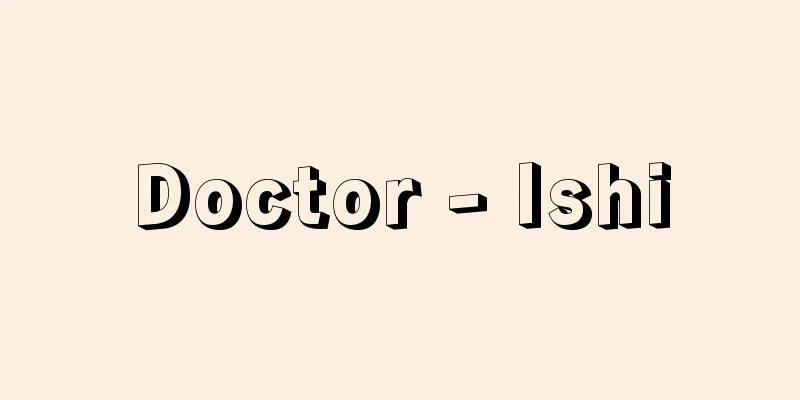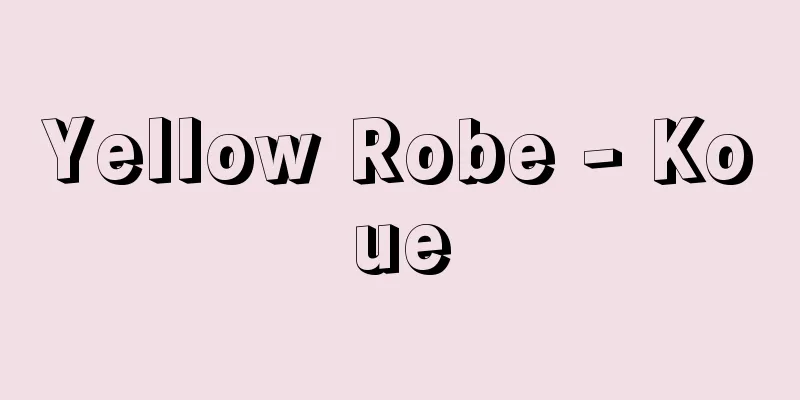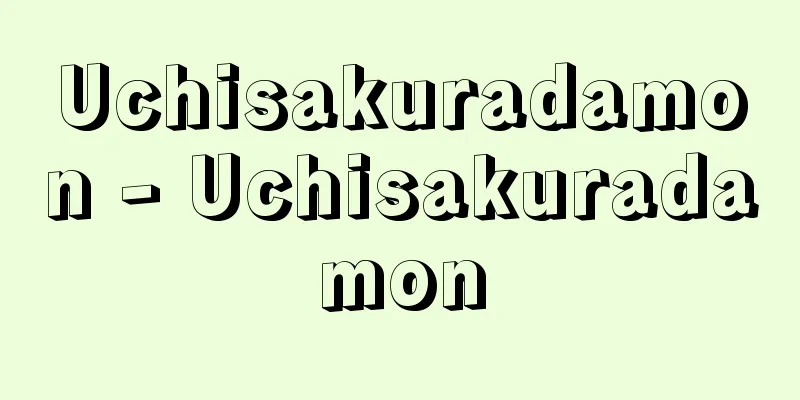Doctor - Ishi

|
A medical practitioner is someone who practices medicine as a profession, and is commonly referred to as a doctor. In Japan today, doctors are subject to the provisions of the Medical Practitioners Act (Act No. 201 of 1948). Article 1 of the Medical Practitioners Act defines a doctor as "a doctor shall contribute to the improvement and promotion of public health by administering medical care and health guidance, thereby ensuring the healthy lives of the people." Furthermore, Article 17 stipulates that "no one may practice medicine unless he is a medical doctor," and Article 18 stipulates that "no one may use the title "doctor" or a title confusingly similar to this unless he is a medical doctor," stipulating the monopoly of medical doctors on medical practice and even the monopoly of their titles. Although medical practice is a medical procedure that improves the pathological parts of patients, the so-called medical practice in legal interpretation is defined as any procedure that may harm or be dangerous to the human body, performed with the medical judgment and skills of a doctor, with the intention of repeatedly and continuously performing such procedures. [Yonezo Nakagawa and Akira Nakagawa] Medical licenseArticle 2 of the law stipulates that "Anyone who wishes to become a doctor must pass the national medical examination and be licensed by the Minister of Health, Labour and Welfare." Those who are eligible to take the exam to obtain a medical license are those who fall under any of the following three categories (Article 11 of the Medical Practitioners Act). (1) A person who has completed a regular medical course and graduated from a university Furthermore, if an individual has become a doctor, and he or she is mentally ill, addicted to narcotics, cannabis or opium, has been sentenced to a fine or more severe punishment, or has committed a crime or misconduct in relation to medical practice, the Minister of Health, Labour and Welfare may revoke the license or order the individual to suspend the practice of medicine for a specified period of time (Articles 4 and 7 of the Medical Practitioners Act). In addition, the chairperson of a medical corporation and the director of a public health center are also required to have a medical license. However, in the case of the chairperson, a non-physician can become the chairperson if approved by the prefectural governor (Article 46-3 of the Medical Care Act, Article 4 of the Enforcement Order of the Regional Health Care Act). [Yonezo Nakagawa and Akira Nakagawa] Medical DepartmentUntil now, the medical specialties that could be advertised were stipulated one by one in the Medical Care Act, but this has now been considerably relaxed, and Article 3-2 of the Enforcement Order of the Medical Care Act (revised in 2008) stipulates the following: [1] Internal medicine [2] Surgery [3] A name that combines internal medicine or surgery with the following items as specified by the Ministry of Health, Labour and Welfare Ordinance (excluding those combinations that are unreasonable in light of medical knowledge and social conventions as specified by the Ministry of Health, Labour and Welfare Ordinance). Because of this, medical specialties not seen before are now being advertised, such as allergy medicine and cosmetic surgery. For similar reasons, dentists are also now advertising orthodontics, pediatric dentistry, oral surgery, and other specialties. However, because a legal specialist system has yet to be introduced in Japan, although many specialist medical societies certify association-certified doctors and specialists, it cannot be said that we have reached a specialist system like that in Europe and the United States. [Yonezo Nakagawa and Akira Nakagawa] historyNext, we will take a general look at the emergence of doctors and their social status. Generally speaking, when a person is ill, it means that they are in a situation where they are unable to deal with physical problems on their own, and so naturally they require assistance from others. Moreover, it is desirable for those who provide assistance to have the knowledge and skills to deal with physical problems. In response to this demand, so-called "medical professionals" were born. By gaining experience and accumulating knowledge, such medical professionals can reach a higher level than the average person, but they are not omnipotent. However, patients cannot help but expect medical professionals to be omnipotent. Thus, when medical professionals are faced with situations that cannot be dealt with through empirical knowledge or skills, they resort to superstitious and supernatural logic. Although this supernatural logic is an emotional logic, it does have a certain calming effect on the anxiety caused by illness. The emergence of professional medical practitioners (doctors) is said to have been found in Mesopotamia and Egypt 7,000 years ago, but in every ancient country, doctors began as sorcerers. The Chinese character for doctor is written as "醫" or "毉". One interpretation of "醫" is that the rooster represents wine and medicine, and the doctor represents an arrow, a sharp blade and surgery, but it is more appropriate to think of the rooster as a vessel offered to an altar and the arrow as a symbolic tool for driving away evil spirits. The character "毉" also includes the character for "miko" (wizard), which indicates that medical practitioners were like sorcerers. The archaic Japanese word for doctor is "kusushi" (medicine). It is said to be a combination of "kusuri" (medicine), but it can also be interpreted as coming from "kusu" (strange), meaning a miracle worker. "Medicine" can also be taken to mean using herbs to achieve the effect of making people feel comfortable, rather than herbs that entertain. In many European countries, the word for medicine comes from the Greek word phàrmakon, which refers to the herbs, roots, and barks used by sorcerers. Thus, medical professionals began with an association with magic, but eventually they came to be linked with religion. Religion supports people's worldview and outlook on life and death, and when it is linked to political power, it also functions to support political power from behind the scenes. The rulers of many ancient nations considered religion and medicine to be political tools of the same root. This tendency is also evident in the ancient nations of Mesopotamia and Egypt. In addition, many religions actively promoted relief for the sick as one of their unique activities. In such cases, it was not uncommon for clergy and medical professionals to be the same person. Hippocrates of ancient Greece, who is said to have separated medicine from witchcraft, was also a member of the Asclepiad, a guild of medical professionals who worshipped the god of healing, Asclepius. In Japan, too, the relationship between Buddhism and medicine is deep. Especially after the Kamakura period, when Buddhism was moving away from the protection of the ruling class and becoming more popular, Buddhist monks actively carried out medical relief work. Many medical professionals also wore robes similar to those of monks. Medical professionals only become independent when they are free from their ties to magic and religion. This happened after the Renaissance in Europe, and the 18th century was the golden age of medical independence. However, even with independence from religion, it was necessary to maintain a different form of "omnipotence" to respond to the needs of patients and society. One of these was to socially and institutionally guarantee that medical professionals had acquired advanced academic knowledge. In Europe, this was placed in the higher education institution of a university, and those who completed the university were given the right to teach others, that is, they were guaranteed this by becoming a doctor. Originally, the term doctor was a qualification derived from the Latin word docēre (meaning to teach). The other was to guarantee the status of a profession collectively. The word "profession" comes from profess (meaning to profess), and classically referred to three types of professionals: doctors, lawyers, and clergy. These three professional fields are called professions because it is difficult for users to judge the quality of the services provided, and therefore practitioners form groups and autonomously regulate each other's qualifications and the ethical performance of services. In order to give the group more authority, it was necessary for them to be recognized by the church or the state, or to have members sign the certification issued by the group. The certification examinations that were born from this background eventually became a system of national examinations. These efforts in Europe did not succeed in monopolizing the business or the name, and it was not until the 19th century that this was possible. On the other hand, Japan's medical system began with the Taiho Code, but since then, there were no higher education institutions open to the common people, so medical professionals did not immediately gain trust as intellectuals. In addition, since there were no medical groups or organizations, it did not develop into a profession. However, from the Kamakura and Muromachi periods onwards, the number of people who provided medical care to the general public gradually increased, and the particularly outstanding among them opened private schools and schools of medicine, and simply sought to gain social and institutional trust by connecting with the schools. The establishment of the status of medical professionals in Japan came even later than in Europe, and it was not until 1869 (Meiji 2) that this was realized, when the government decided that future medical science and healthcare would be modelled on Germany. I have provided a historical overview of the independence of the status of doctors and medical professionals, but when we look at the medical world today, we can say that doctors are trying to overcome the uncertainty of knowledge and technology and gain social trust by backing themselves with science. [Yonezo Nakagawa and Akira Nakagawa] "An Eye for Medicine" by Nakagawa Yonezo (1967, NHK Publishing)" ▽ "Modern Medicine Lecture Series 4: Medical Education" edited by Kawakami Takeshi and Nakagawa Yonezo (1972, Nippon Hyoronsha)" ▽ "New Introduction to Medicine" by Yoshitoshi Kazu and Nakagawa Yonezo (1977, Shinohara Publishing)" ▽ "The Real Face of Doctors - Considering Medicine at a Turning Point" by Nakagawa Yonezo (1993, Kodansha)" ▽ "Interpretation of the Medical Care Act and Medical Practitioners Act (Dental Practitioners Act) 6th Edition edited by General Affairs Division, Health Policy Bureau, Ministry of Health, Labor and Welfare (1994, Igaku Tsushinsha)" ▽ "Talking about Medicine - Improving the Quality of Doctors and Exploring Medical Care for Patients" by Kurokawa Kiyoshi and Tanabe Isao (1995, Nishimura Shoten)" ▽ "What is a Good Doctor? - A Study of Good Doctors and the Medical Care System" by Minami Kazuo (1995, Shinko Medical Publishing)" ▽ "Uncertainty in Medicine" by Nakagawa Yonezo (1996, Nippon Hyoronsha)" ▽ "Why Can't Doctors Cure? by Bernard Lown, translated by Koizumi Naoko (1998, Tsukiji Shokan)" ▽ "Practical and Legal Knowledge Necessary for Doctors" 3rd Edition by Igarashi Katsuro (1998, Chugai Igakusha)" ▽ "Creating the Best Medical Care in the World - Doctors' Choices (Overseas Edition)" edited by Nose Yukihiko (1999, Haru Shobo)" ▽ "Can Doctors Change? - In Search of New Possibilities in Medical Care" by Mano Toshiki (2000, Haru Shobo) ▽ "Dismantling the Image of a 'Doctor'" by Hervé Hamon, translated by Nozaki Saburo (2002, Haru Shobo)" ▽ "Considering Medical Care and the Law" by Higuchi Norio (2007, Yuhikaku)" ▽ "Tohoku University Graduate School of Medicine, Department of Regional Medical Systems (Miyagi Prefecture), Donated Lecture Series, "Tohoku University Regional Medical Symposium Lectures: Doctor Shortage and the Collapse of Regional Medical Care 1, 2" (2007, 2008, Japan Medical Planning)" ▽ "Nakahara Hideomi and Okada Naoko, "Medical Collapse: Adrift Patients, Exhausted Doctors" (2008, PHP Institute)" [References] | | | | | | | doctor | |Source: Shogakukan Encyclopedia Nipponica About Encyclopedia Nipponica Information | Legend |
|
医療を業として行う者をいい、俗に医者ともよばれる。現在の日本における医師の場合は、医師法(昭和23年法律第201号)の定めに従うこととなっている。すなわち、医師法の第1条では、「医師は、医療及び保健指導を掌(つかさど)ることによって公衆衛生の向上及び増進に寄与し、もって国民の健康な生活を確保するものとする」とあり、医師の定義がなされている。さらに第17条は、「医師でなければ、医業をなしてはならない」と定め、第18条では、「医師でなければ、医師又はこれに紛らわしい名称を用いてはならない」とし、医療に関する医師の業務独占、さらに名称についての独占を規定している。医業は患者のもつ病的な部分を改善していく治療行為ではあるが、法解釈上でのいわゆる医業とは、医師の医学的判断や技術をもって、人体に危害を及ぼしたり、または危険を及ぼすおそれのあるいっさいの行為を、反復継続する意志のもとに行うこととされている。 [中川米造・中川 晶] 医師免許医師の免許は、第2条で「医師になろうとする者は、医師国家試験に合格し、厚生労働大臣の免許を受けなければならない」と定められている。この医師免許を受けるための受験資格をもつのは、次の三つのいずれかに該当する者とされる(医師法11条)。 (1)大学で医学の正規の課程を修めて卒業した者 また、医師となった者でも、それが精神病者、麻薬・大麻もしくはアヘンの中毒者、罰金以上の刑に処せられた者、医事に関し犯罪または不正の行為のあった者である場合には、厚生労働大臣は免許を取り消したり、または、期間を定めて医業の停止を命じることができると定められている(医師法4条、7条)。 なお、基本的には医療法人の理事長、保健所の所長も医師免許が必要であるとされている。ただし、理事長の場合、都道府県知事の認可を受けた場合は非医師でも理事長になることができる(医療法46条の3、地域保健法施行令4条)。 [中川米造・中川 晶] 診療科目広告することのできる診療科目については、これまでは一つ一つ医療法で規定されていたが、現在はかなり緩和され、医療法施行令第3条2(平成20年改正)では以下のように規定されている。 〔1〕内科 このため、これまでには見かけなかった診療科が標榜(ひょうぼう)されるようになっている。アレルギー内科や美容外科など。また歯科医師についても同様の事情で矯正歯科、小児歯科、口腔(こうくう)外科などの科目が標榜されるようになっている。しかしながら、日本では法律上の専門医制度がいまだに導入されていないため、多くの専門医学会が学会認定医や専門医の認定を行っているが、欧米のような専門医制度に至っているとはいいがたい。 [中川米造・中川 晶] 歴史次に、医師の発生と社会的な地位について概観してみる。 一般に人間が病気であるということは、身体的な問題に対して、自らが対処できないという状況を意味するわけであり、当然、他人の援助が要求される。しかも、援助する者は、身体的な問題について対処しうる知識と技能をもっていることが望まれる。こうした要求にこたえて生まれるのが、いわゆる「医療者」である。こうした医療者は、経験を積み、知識を集めることで、一般の者よりは高いレベルに達することはできるが、万能ではない。しかし病人は、医療者に対して万能であることを期待してやまない。そこで医療者としては、経験的な知識や技術では対応できない局面には、迷信的で超自然的な論理をよりどころとして臨むこととなる。こうした超自然界の論理は、感情の論理ではあるが、病気による不安に対しては一定度の鎮静効果はもつものである。 職業的な医療者(医師)の発生は、7000年前のメソポタミアやエジプトにも認められるといわれるが、古代のどの国家においても、医師の始まりは呪術師(じゅじゅつし)としてであった。 中国での医の正字は「醫」または「毉」と書く。「醫」の解釈として、酉は酒で薬物を、医は矢、つまり鋭利な刃物で外科を意味するという考えもあるが、酉は祭壇に捧(ささ)げる容器であり、矢は悪霊退散の象徴的器具と考えるのが妥当であろう。「毉」という字では、つくりに「巫(みこ)」が含まれていることからも、医療者は呪術師的な存在であったことを示している。 日本において医師にあたる古語は「くすし」(薬師)である。これは「くすりし」が詰まったものともいわれるが、「奇(く)す」、つまり奇跡を行う者という意味から出たとも解される。また「薬」は楽しませる草というよりは、楽な気分に変える作用を草によって達成させようという意味にもとれる。 ヨーロッパ各国で、薬を意味する言語の多くは、ギリシア語のファルマコンphàrmakonに由来するが、これは、呪術師の用いる草根木皮の類をさしている。 医療者は、このように呪術との関連から出発したわけであるが、やがて宗教と結合する段階が生まれてくる。宗教は人々の世界観や死生観を支えるとともに、それが政治権力と結び付くとき、政治権力を裏側から支える機能をも果たすことになる。多くの古代国家における支配者は、宗教と医療とを同根の政治の用具と考えた。メソポタミアやエジプトにおける古代国家でも、この傾向は明らかである。 また多くの宗教では、宗教独自の活動の一つとして、病者の救済が積極的に進められた。こうした場合、聖職者と医療者は同一人であることが珍しくなかった。呪術から医術を独立させたといわれる古代ギリシアのヒポクラテスも、治療神アスクレピオスを信奉する医療者組合「アスクレピアド」の一員であった。 日本でも、仏教と医学の関係は深い。とくに鎌倉時代以降、仏教が為政者の保護を離れて大衆化していくときに、僧侶(そうりょ)は医療的救護事業を盛んに行った。また医療者にも、僧侶のような衣服をまとう者が多かった。 医療者が呪術との関係、宗教とのかかわりから離れたとき、初めて医療者の自立が始まるが、それは、ヨーロッパではルネサンス以降であり、18世紀は地位確立の最盛期であった。しかし、宗教からの独立ということはあっても、病人や社会からの要請にこたえる「万能観」は別の形で持ち続ける必要があった。その一つは、高度の学問を身につけた者であることを社会的、制度的に保障することであった。ヨーロッパでは、これを大学という高等教育の場に置き、修了した者は、他の者を教える権利を授けられ、つまりドクターとなれることで、これを保障した。元来ドクターとは、ラテン語のドセレdocēre(教えるの意)から生み出された資格である。もう一つは、プロフェッションとして集団的に身分を保障することであった。プロフェッションとは、プロフェスprofess(公言するの意)に由来することばで、古典的には、医師、法律家、聖職者の三つの職能者をさすものであった。この三つの職種領域は、利用者からみると、そのサービスの内容程度についての判断が困難であるところから、同業者が集団をつくり、自律的に資格やサービスの倫理的遂行について規制しあうことをプロフェスするために、プロフェッションとよばれたわけである。 この職能者集団は、団体の立場を、より権威づけるためには、教会なり国なりに承認してもらうか、あるいはその団体の発行する資格証明書の署名人になってもらうことが必要であった。このような背景から生まれた資格試験は、国家試験という制度となっていくわけである。こうしたヨーロッパにおける努力も、なかなか業務独占、名称独占には成功せず、19世紀に至って初めて可能となった。 一方、日本の医事制度は『大宝律令(たいほうりつりょう)』に始まるが、それ以後、庶民に開かれた高等教育組織がなかったために、医療者は、ただちには知識人としての信頼は得られなかった。また、医療者の集団や組織化もなかったために、プロフェッションへの発展もなかった。ただ、鎌倉・室町時代以降になると、一般大衆の医療を業とする者がしだいに増加し、そのなかでとくに傑出した者が私塾を設けて流派を開き、流派につながることで、社会的、制度的な信頼を得ようとしたにすぎなかった。 日本での医療者の地位確立は、ヨーロッパよりはさらに遅れ、1869年(明治2)政府が以後の医学および医療をドイツに範をとることを決定して、初めて具体化されたのである。 医師ないしは医療者の地位独立についての歴史的概観を述べたが、現在の医学界を眺めたとき、医師は、科学を背にすることによって、知識・技術の不確実性を克服し、社会的な信頼を得ようとしているということができよう。 [中川米造・中川 晶] 『中川米造著『医学をみる眼』(1967・日本放送出版協会)』▽『川上武・中川米造編『講座現代の医療 4 医学教育』(1972・日本評論社)』▽『吉利和・中川米造著『新医学序説』(1977・篠原出版)』▽『中川米造著『素顔の医者――曲がり角の医療を考える』(1993・講談社)』▽『厚生省健康政策局総務課編『医療法・医師法(歯科医師法)解』第6版(1994・医学通信社)』▽『黒川清・田辺功著『医を語る――医師の質を高め患者のための医療を探る』(1995・西村書店)』▽『南和嘉男著『「良医」とは何か――「良医」と「医療制度」の研究』(1995・新興医学出版社)』▽『中川米造著『医学の不確実性』(1996・日本評論社)』▽『バーナード・ラウン著、小泉直子訳『医師はなぜ治せないのか』(1998・築地書館)』▽『五十嵐勝朗著『医師に必要な実務、法的知識』第3版(1998・中外医学社)』▽『能勢之彦編著『世界のベスト医療をつくる――医師たちの選択(海外編)』(1999・はる書房)』▽『真野俊樹著『医師は変われるか――医療の新しい可能性を求めて』(2000・はる書房)』▽『エルヴェ・アモン著、野崎三郎訳『「医師」像の解体』(2002・はる書房)』▽『樋口範雄著『医療と法を考える』(2007・有斐閣)』▽『東北大学大学院医学系研究科地域医療システム学(宮城県)寄附講座編『東北大学地域医療シンポジウム講演録 医師不足と地域医療の崩壊1、2』(2007、2008・日本医療企画)』▽『中原英臣・岡田奈緒子著『医療破綻――漂流する患者、疲弊する医者』(2008・PHP研究所)』 [参照項目] | | | | | | | | |出典 小学館 日本大百科全書(ニッポニカ)日本大百科全書(ニッポニカ)について 情報 | 凡例 |
Recommend
Sporozoa - Homones
A general term for protozoa of the class Sporozoa....
Ichthyornis (English spelling)
A fossil bird that lived in North America during t...
Robert, Hubert
Born: May 22, 1733, Paris [Died] April 15, 1808. P...
idola specus (English spelling) idolaspecus
…In this sense, it is the same as a statue of a g...
Peter Grimes
An opera (op. 33) by the British composer Britten....
Pre-indictment settlement - Kisozen no wakai
... Mediation of labor disputes by the Labor Rela...
Ozma Project - Ozuma Keikaku (English)
This project was the starting point of attempts t...
Myoboudou
It was a department of the Daigakuryo, where rese...
CERN - Serun
Abbreviation for the European Organization for Nu...
Emperor Jing
187 BCE - 141 BCE China, former Han Emperor Liu Qi...
Environmental rights
The right to enjoy clean air and water, and a qui...
Yoshikawa Akimasa
Year of death: January 10, 1920 Year of birth: Tem...
allegro
…There are various arabesques depending on the po...
Okura Hachiemon Family
...The style of the play is said to be robust and...
Red seal letter - Shuinjo
A type of samurai document from the Sengoku to Ed...









